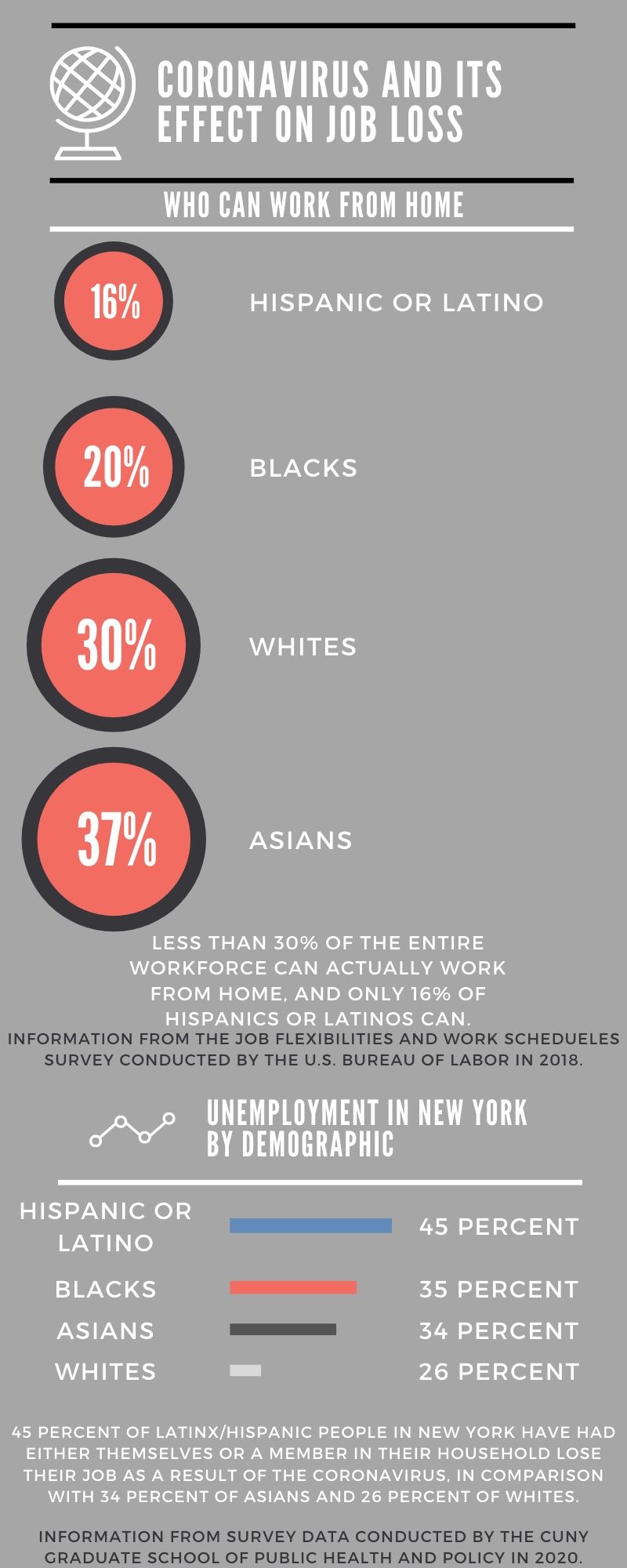
By Maya Brown
Juan Fuentes has been a waiter at The Cuban, a restaurant in Garden City, New York, for almost four years. There, the 20-year-old averaged $800 a week, including tips, but had to take a break from wearing his white Cuban hat when, on March 16, New York Gov. Andrew Cuomo announced that all bars and restaurants would be closed indefinitely to stop the spread of the coronavirus (COVID-19). Fuentes applied for unemployment the following week, and is expecting a weekly check of $275 to get by.
Cuomo ordered 100 percent of non-essential workforces would have to stay home during a coronavirus briefing on March 20, making many New York workers work remotely, and many others left without a job. The New York State Department of Labor said the unemployment insurance claims have increased by a minimum of 284 percent with more than 80,500 claims filed. Less than 30 percent of the entire workforce can actually telework, according to the Job Flexibilities and Work Schedules Survey conducted by the U.S. Bureau of Labor in 2018.
“It’s very difficult because for anyone who starts to make that amount of money, you budget yourself to what you have,” Fuentes said. “Not seeing that money and seeing your bills at the end of the month it’s scary.”
In response to immediate coronavirus concerns, The Cuban announced that the seating capacity would be reduced to 50 percent, which downsized staffing tremendously. That same week, the busy restaurant moved to takeout only, and only one waiter was able to work at a time. Soon, the restaurant closed indefinitely.
“In the span of a week, I went from a weekly schedule to a low amount of shifts to none,” Fuentes said.
Only 16 percent of Hispanic workers have jobs that even allow that kind of flexibility. Professor Scott Ratzan, a senior scholar at the CUNY Graduate School of Public Health and Policy, led a survey that found that, when it comes to New York, the Latinx/Hispanic communities have been hit the hardest.
“It’s likely because the Hispanic community, many are in service jobs like restaurants or hotels,” Ratzan said in a statement.
Additional survey data also shows that 45 percent of Latinx/Hispanic people in New York have had either themselves or a member in their household lose their job as a result of the coronavirus, in comparison with 34 percent of Asians and 26 percent of Whites. Fifty-six percent of the Latinx/Hispanic community also say they will not be able to pay either their rent or mortgage next month.
“Demographics offer an important layer to this analysis and can garner an understanding of where inequities lie in the socioeconomic fallout of a public health emergency,” Lauren Rauh, a research assistant at the CUNY Graduate School of Public Health and Health Policy said.
Wascal Montero, a Hispanic resident of Roosevelt, has been a landscaper with Rodriguez Landscaping for almost two years. On March 21, he got notice that he would no longer be able to work after Cuomo made the announcement.
“Right now I am not doing anything to earn money,” Montero said. “I am just staying in the house and it’s hard.”
Working remotely also isn’t an option for those in the restaurant industry, as it thrives on social interaction in a fast-paced environment. Under Cuomo’s decision, restaurants that wanted to stay open were only allowed to conduct takeout and delivery services. Some decided to temporarily fully close down.
Havana Central of Garden City, New York would bring in about 900 people a week for dining and live music. The restaurant decided to close down indefinitely, including its takeout services, due to safety concerns. Now, seats can be found empty and there is only silence inside. Juan Carlos Gomez, its general manager, and about another 100 employees were laid off as a result of the closure.
“In the restaurant business, for any employee who has lost their job, the recovery time will take some time,” Gomez said. “Things are not going to be the same.”
More than three million people have filed for unemployment in the United States in two weeks, since the COVID-19 outbreak.
“We need to come and work together to overcome what is going on at the current time,” Mateo Flores, Chairman of the Nassau County Hispanic American Advisory Board said. “For those that have the opportunity to collect unemployment, they need to apply.”
For workers who have filed for unemployment are waiting to get their jobs back, the timeline is uncertain.
“Basically, there’s nothing I can do, I just have to wait and hope for the best and see what happens,” Fuentes said.
Flores urged those who have lost their jobs to reach out to community-based organizations for basic help, including food and help with applying for unemployment.
“We need to try to find a way to survive and a way that the government will help the entire community,” he said.

